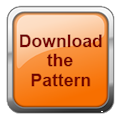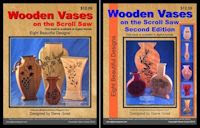The Largemouth Bass pattern is 10.25" long. There are two 1/4" thick layers.
Here are three tips for a more successful bass fishing trip.
I wish this photo of me were real, but it is not. It was generated by AI.
I have never caught a fish that large in freshwater. I have been deep-sea fishing and
caught a Mahi-Mahi fish that was a bit larger than this imaginary largemouth bass.
I enjoyed the deep-sea fishing, but on the second day, I got seasick, which was not fun.
It has been several years since I went fishing. I enjoy the time on the lake more than I enjoy the fishing.
How are these images created?
Here is the process for creating these AI-generated images. They are getting better almost daily. There is a certain amount of controversy in generating this type of content. Some of the controversy is warranted, and some is just speculation. We are in the early days of the AI explosion, and it is nearly impossible to predict where it will go, but it is going to go.
 I understand that not all of you are fans of the AI content I produce, but some are, and I enjoy it, so it is fine to just skip this section completely. This is to answer questions that some of you have asked. I use a few different AI services. They are all slightly different, and some are better for one task and not another. In the case of these two images, I used ChatGPT 4.0. The image on the left was the reference image, and here is the prompt. "I see myself in hunting clothes, wrestling an alligator on the ground. I am holding his mouth open with both of my hands and struggling mightily."
I understand that not all of you are fans of the AI content I produce, but some are, and I enjoy it, so it is fine to just skip this section completely. This is to answer questions that some of you have asked. I use a few different AI services. They are all slightly different, and some are better for one task and not another. In the case of these two images, I used ChatGPT 4.0. The image on the left was the reference image, and here is the prompt. "I see myself in hunting clothes, wrestling an alligator on the ground. I am holding his mouth open with both of my hands and struggling mightily."After that, the AI takes over, and here is a brief set of steps the AI goes through to create the image.
1. The Basics: It starts with random noise.
Imagine a screen full of pure TV static — just a mess of black-and-white dots.
That's the starting point. Absolutely nothing recognizable at all.
2. Guided by a model: Enter the trained AI brain.
The AI has been trained (on millions of pictures) to know what things like "dog," "tree," or "truck" should look like.
Training means it’s spent weeks (or even months) adjusting billions of little weights (think: dials or knobs) to get better and better at recognizing and creating realistic patterns.
3. The magic technique: "Diffusion" or "transformers."
Two main tricks used today:
Diffusion models (like DALL·E 3, Stable Diffusion) slowly remove the noise, step-by-step, "guessing" and "correcting" until a clear image forms.
It's like sculpting — chip a little here, refine a little there.
Transformer models (like Midjourney uses under the hood) predict how to "build" the image piece-by-piece, more like a painter with a brush.
4. Guided by words: Text-to-image.
If you give it a prompt like "A dog wearing a cowboy hat riding a skateboard,"
the AI turns those words into vectors (mathematical coordinates for ideas).
It then uses those to steer the generation — "okay, the shape should be a dog... wearing something on its head... something that looks like a skateboard underneath..."
5. Feedback loop: Does it look right yet?
At each step, the AI checks itself:
"Is this closer to what a skateboard-riding cowboy dog should look like?"
If yes, keep refining. If no, adjust.
6. After a few hundred steps: BOOM.
You end up with a full, detailed image — even though it started from total random noise.
Tiny bit deeper (but not crazy technical):
Training uses pairs of images and captions. ("This is a horse standing in a field.") The AI learns to connect words and images.
The AI learns to spot patterns like "four legs + mane = horse."
It uses neural networks, inspired loosely by how real brains work (layers and layers of fake "neurons").
Summary in plain English:
AI art is like starting with a blank canvas covered in random specks and then, using memory from seeing a billion pictures, slowly "correcting" the static into something that matches what you asked for.
It’s an incredibly fast, tireless dreamer that paints what it imagines.

Largemouth Bass Pattern
Email Newsletter Readers: Remember that the Newsletter is just a copy of the daily blog post. To see the post in its proper formatting click this link. If you ever misplace a pattern or any item you see here you can always find it on the blog. Everything stays on the blog forever.
Every Scrollsaw Workshop Pattern from 2007-2024 on USB drive, or Instant Download. Over 4,900 Patterns!
Purchase the entire Scrollsaw Workshop pattern catalog for offline access.You will never run out of fun patterns to cut.
Two delivery options.
After payment, you will receive an email with the download link. This is a large file. You should not attempt to download it on a tablet or smartphone. It is a compressed file that will need to be extracted to your hard drive. Basic computer skills are necessary to extract the file.
Click this link to order the USB Drive
The USB drive contains all the Scrollsaw Workshop Patterns. The drive is $25 plus shipping and handling. Now, with the new distributor the drive ships to the US and many other countries. The shipping can get expensive to some international locations, so the Instant download option above is probably more desirable.
My two "Wooden Vases on the Scroll Saw" books make it easy.
The books are $12 each and are available for instant download after purchase. Click for a Video Demonstration.
My Sponsors:
Support the businesses that support our community.
Home of Pegas scroll saw blades.
















